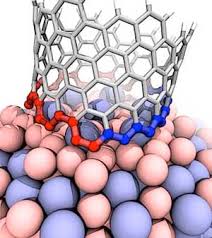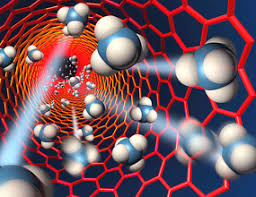Distribution of nanotubes with NIR-vis-UV absorption spectroscopy (nano-microelectronics)
Researcher and author: Dr. ( Afshin Rashid)
Note: The distribution of nanotubes by absorption spectroscopy of two adjacent nanotubes with the interaction of carbon with van der Waals bond energy can cause the formation of parallel clusters or strands . Creating a handle in the electronic structure of the tubes causes turbulence and causes the red shift of their absorption peaks, which causes the peaks to overlap and fade, and ultimately obscures the structure of the spectrum.
In addition, the presence of clusters prevents the selective reaction of internal nanotubes, which confuses the purification of nanotubes by size or type or their use as macromolecular species . Therefore, NIR-Vis-UV absorption spectroscopy can be used to examine the sample population or the degree of grouping of the sample. If the distribution of nanotubes by NIR-vis-UV absorption spectroscopy is desired, the sample should be dispersed or in a thin layer . Optical absorption assays provide useful information about the electronic properties of SWCNTs and can be used to study covalent and non-covalent interactions between molecules and nanotubes.
When the functional groups are covalently placed on the nanotube, the absorption peaks are quite attenuated or even disappear because the structure of the nanotube in some hexagonal SP2s changes to the structure of the parts of the SP3 structure . NIR-VIS-UV absorption spectroscopy has two important uses: the rate of covalent reactions and the selectivity of different nanotubes . Non-covalent doping or molecular adsorption produces valence-like electrons (dopingP ) or saturation of the conduction band (doping-n). These non-covalent interactions can affect the intensity of absorption peaks . When doping, electron donors such as (Cs, K) or electron acceptors They make very similar changes in the (-Br2 ) spectrum, such as NIR-vis-UV, both of which attenuate electron transitions. Use absorption spectroscopy to estimate the abundance of metallic and semiconductor species by comparing the peaks intensity; Because the position of these resonant peaks depends on chirality and diameter. For qualitative analysis , absorption spectroscopy is excellent because it shows the overall appearance of the sample composition; But quantitative evaluation depends on (m, n) for several possible reasons for the uptake of nanotubes . It is reported that the ratio of extinction coefficients for metal to semiconductor SWCNTs is 0.352, which should be independent of the separation method - 0.009 or starting material. But the values The extinction coefficients of SWCNTs reported in scientific sources are not consistent and better measurement methods are still needed to determine the extinction coefficient of different nanotubes (m, n). Second, the strong absorption of π in the short wavelength region makes the resonance transmissions not distinct.
Conclusion :
Some samples have large impurities, such as graphite polyhedral particles, amorphous carbon, and catalyst particles. The light absorption of these impurities is related to the spectrum and it is necessary to quantitatively evaluate the elimination of the field absorption field, which in this case is not possible and a little analysis will be associated with error . The third problem is due to the presence of dispersant that is dispersed when the nanotube is dispersed, the presence of which leads to misdiagnosis in quantitative detection of SWCNT in the state.
In addition, the complexity of courier overlap is problematic. As a result, the presence of a large number of SWCNTs with different (m, n) with unknown frequency along with various errors along with data analysis, makes it difficult to quantify the concentration of specific species (m, n) in the sample and only estimated data to Is achieved.
Researcher and author: Dr. ( Afshin Rashid)
PhD in Nano-Microelectronics





